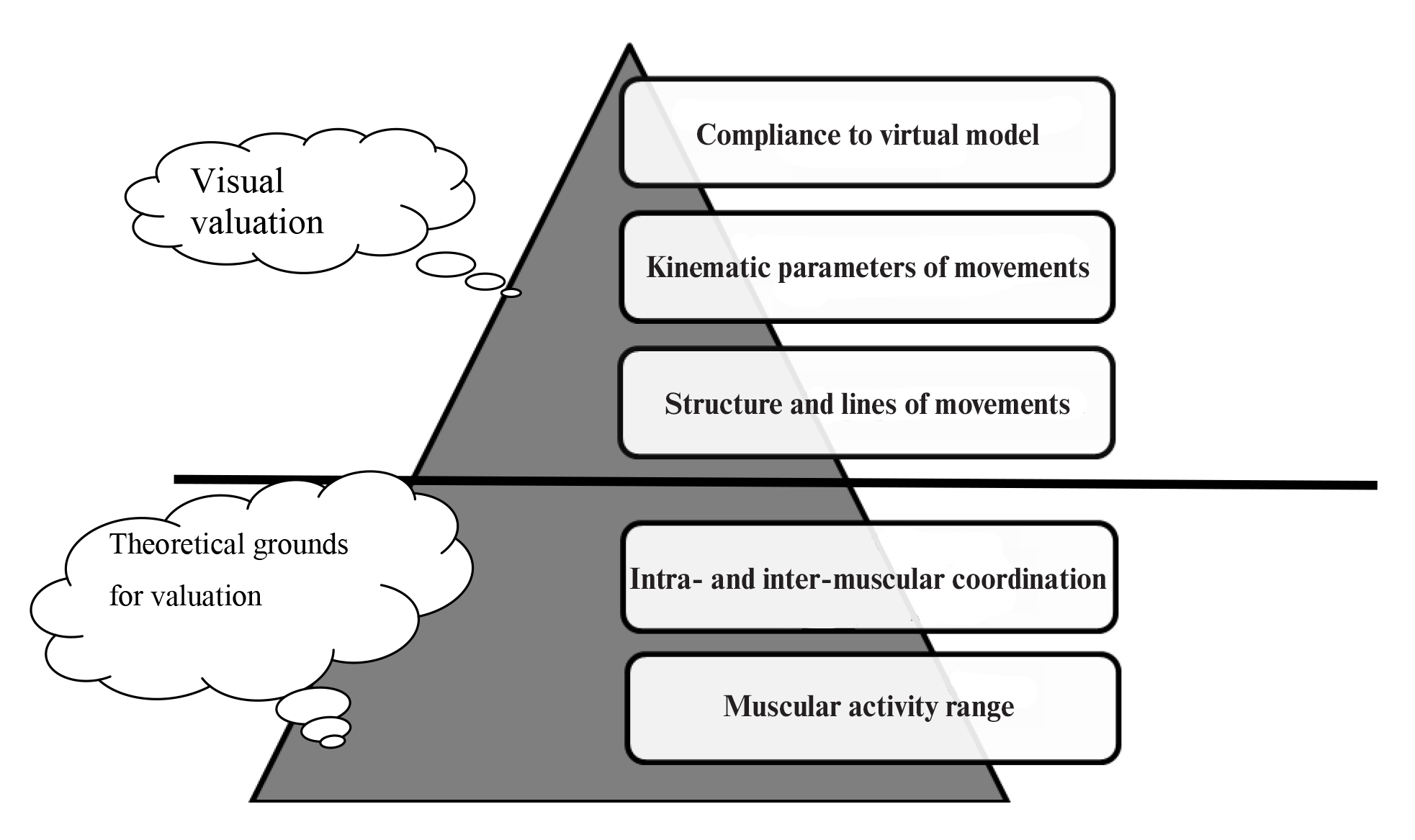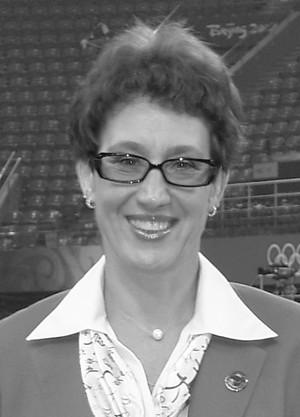Objective metrics in technical exrcution quality scoring for benefit of long-term training process in rhythmic gymnastics
Фотографии:
ˑ:
Professor, Dr.Hab., Honorary Judge FIG R.N. Terekhina
Professor, Dr.Hab., Honorary Coach of Russia I.A. Viner-Usmanova
Professor, PhD, Internationally Certified Judge (FIG) E.S. Kryuchek
Professor, PhD, Honorary Figure of Physical Culture RF E.N. Medvedeva
Professor, Dr.Med. R.B. Tsallagova
Keywords: rhythmic gymnastics, performance mastery, competitive execution difficulty, technical values of elements, expert valuation, objective metrics.
Background. Progress of any sport discipline largely depends on how impartial are the assessments of the athletic accomplishments. This is true first and foremost for the sports where athletic accomplishments are scored by subjective metrics. In view of the high progress and growing achievements in modern rhythmic gymnastics, the problems of expert valuations of the athletic performance mastery are getting more and more critical [1, 4]. Knowing that sport progress implies the competitive routines being increasingly difficult, the sport needs a set of appropriate performance criteria being precisely identified for the technical merits of every element in the movement sequences being fairly scored.
Scoring of the competitive execution difficulty is regulated today by the Code of Points as a basic regulatory document of the FIG (Fédération Internationale de Gymnastique, International Federation of Gymnastics). However, the rules of competitions are subject to changes and amendments in every Olympic cycle, with the difficulty notes being now and then moved from one group to another or totally excluded from the rules of competitions thereby restricting the arsenal of tools and skills applied by gymnasts in their competitive exercises. Modern rhythmic gymnastics is a highly popular Olympic sport discipline with its records being made under the popular slogans “Faster! Higher! Stronger!” And it is only natural that the key document that regulates the sport development management process shall contain no provisions of restricting effect on the accomplishments and records in the sport. Highest achievements in modern rhythmic gymnastics require the movement coordination difficulty reaching the highest degrees. That is why it is so important to ensure that the actual value of every technical element is fairly scored. However, the valid rules of competitions give very loose scoring frames for the difficulty scores of the structural groups, and this is one of the reasons for the accomplishments in modern rhythmic gymnastics being scored so inconsistently, with the valid scoring system being of restraining effect on the sport progress on the whole. In this context, we would emphasize the need for more detailed criteria being applied to valuate merits of the elements based on more objective metrics to secure the modern competitive routines being fairly scored. We believe that a real value of each element in rhythmic gymnastics must be scored based on the biomechanical regularities of the motor actions being duly accounted by objective metrics [2, 3].
Objective of the study was to identify a set of the technical execution scoring criteria for the benefit of modern rhythmic gymnastics.
Methods and structure of the study. On request of the Technical Committee of the International Federation of Gymnastics, a team of experts from the Gymnastics Theory and Practice Department of P.F. Lesgaft State University performed a special study using a set of modern instrumental methods. Having assigned a significance level to every criterion applied under the study, we identified the hierarchy of the criteria and their application sequence in the competitive execution difficulty scoring algorithm (see Figure 1 hereunder).

Figure 1. Hierarchy of the difficulty criteria applied to score technical elements of the competitive routines in the modern rhythmic gymnastics
Visual scoring system efficiency depends on how good is the theoretical competency of the expert that should have due knowledge of muscular activity forms, intra- and inter-muscular coordination skills in execution of different movements etc. External expressivity as a harmonic product of muscular activity – provided the execution is perfect and masterful – makes an impression of easiness on spectator and, hence, may not always clearly demonstrate the true and objectively measurable difficulty of the elements performed.
In the process of the technical merits of rhythmic gymnastics competitive routines being rated, the exercise structure is assessed in the first place. The structure means the certain model movement sequence in the element irrespective of the individual styles and traits of the gymnasts. Valued next are the kinematical parameters of the exercise and their correspondence to the virtual model as outlined by the rules of competitions. In this context, a clear vision of the model difficulty level is pivotal for the technical merits of the exercise being precisely valued, with such vision being based on due theoretical knowledge that should leave no room for any doubt as to the relevance of the execution rating criteria and the scoring standards.
The study team used the systemic data generated by the instrumental diagnostics and mathematical analyses to specify a set of difficulty criteria that were used to design the difficulty valuation algorithms and, as a result, the technical elements valuation matrices applicable to the structural groups of exercises in rhythmic gymnastics.
Experimental tests of the above valuation method to rate technical merits of competitive routines made it possible to rate the general expert valuation efficiency in terms of the structural group elements difficulty ratings and the relevant gymnasts’ execution scorings.
Conclusion. The study demonstrated the promising method to perform adequate technical quality valuations and improve the expert valuation efficiency by means of the updated execution scoring system based on a theoretically grounded competitive execution difficulty rating criteria. The study findings were used to draft a basic regulatory document for the global rhythmic gymnastics management process, i.e. the rules of competitions approved by the FIG (International Federation of Gymnastics) for the upcoming Olympic cycle of 2017 through 2020. The recommended structural group elements difficulty rating matrices can be used as a basis for the elite gymnasts’ training systems applicable at different stages of the pre-season training systems both in Russia and the world over.
References
- Viner-Usmanova I.A. Analiz rezul'tatov chempionata Evropy po khudozhestvennoy gimnastike v Minske (Analysis of results of the European Rhythmic Gymnastics Championship on in Minsk) / I.A. Viner-Usmanova, R.N. Terekhina, M. Shishkovska, E.A. Pirozhkova // Uch. zapiski un-ta im. P.F. Lesgafta. – № 6(76). – 2011. – P. 24 – 27.
- Gorodnichev R.M. Sportivnaya elektroneyromiografiya (Sport electroneuromyography) / R.M. Gorodnichev. – Velikie Luki: VLSAPC (VLGAFK), 2005. – 230 p.
- Samsonova A.V. Biomekhanika myshts: uchebno-metod. posobie (Muscle biomechanics: teaching aid) / A.V. Samsonova, E.N. Komissarova. – St. Petersburg, 2008. – 127 p.
- Terekhina R.N. Retrospektivny analiz sorevnovatel'nykh rezul'tatov vedushchikh gimnastok mira (Retrospective analysis of competition results of the leading female gymnasts of the world) / R.N. Terekhina, E.S. Kryuchek, E.N. Medvedeva, I.A. Viner-Usmanova // Uch. zapiski un-ta im. P.F. Lesgafta. – № 1(131). – 2016. – P. 255-259.
Corresponding author: zavkaf58@mail.ru
Abstract
Opinions on modern gymnastics being too difficult and coming to the natural limit in its progress are unlikely reasonable enough. Those female gymnasts who invent new original elements and demonstrate highly difficult compositions to create highly appealing images by the movement sequences and musical illustrations are still successful in competitions, and this is the core logic of modern elite sport. However, modern rhythmic gymnastics faces the global problem of the due impartiality being ensured in the competitive execution difficulty scoring practices. The valid rules of competitions approved by the FIG (International Federation of Gymnastics) make no provisions for fair scoring of technical quality of elements in every structural group. It casts doubts on the gymnasts’ rankings being fairly matched with their actual performance mastery; and the situation is of disruptive effect on the natural progress of the sport discipline in general. Competitiveness of the national school of rhythmic gymnastics with its strong leadership ambitions and sound standards will be determined in the new conditions by its sensitivity to innovations and the most advanced trends in the sport.



